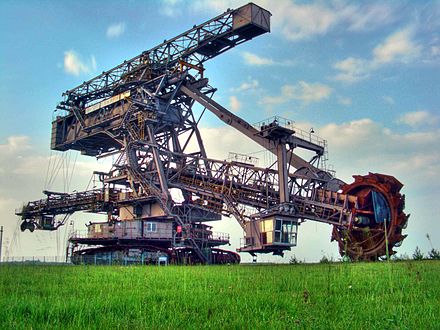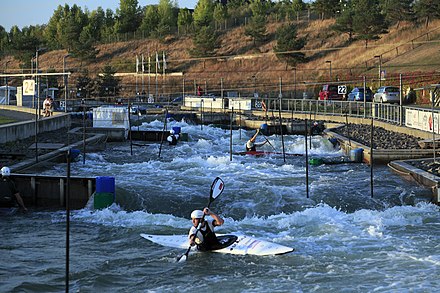Central German Lake District - region in Germany
The Central German Lake District (German: Mitteldeutsches Seenland) is an area of artificial lakes created from former open-cast lignite mines in Saxony, Saxony-Anhalt and the northeasternmost parts of Thuringia around Altenburg. The area is somewhat ill-defined and the immediate surroundings of Leipzig, by far the biggest city in the area are separately marketed as Leipziger Neuseenland ("Leipzig Lake District" or more literally "Leipzig new-lake-land")
Understand
An area formed by mining


During GDR times, it was however also used for metallurgical and chemical purposes and there are to this day factories turning the coal dust into briquettes for use in home heating. In Germany, one can buy lignite briquettes at stores like Obi. A further problem of lignite is its high sulphur content, which when burned produces substances responsible for acid rain. Central German lignite is particularly bad in that regard. During the GDR times, the "solution" was to just build high smokestacks to disperse the pollution over as wide an area as possible (including adjacent countries) but these days the power plants have been fitted with scrubbing devices.
From coal pits to lakes
As the lignite often lies under several dozen meters of overburden (which had to be removed) and well below the natural water table, the water table had to be lowered during mining, creating all sorts of problems. Once a pit had been exhausted, keeping the water table lowered would no longer be sensible and thus they were either filled back up with overburden (still leaving a height difference of the coal seams which could reach several meters) or left to fill up with water. However, the groundwater would seep through minerals like pyrite oxidizing them and creating low pH waters known as "acid mine drainage" which would severely damage and disrupt the local ecosystem and make the lakes unusable. In at least one case, GDR authorities used wastewaters from aluminum production (which has a very high pH) to neutralize the acid water, but in most cases water from local rivers is used to flood the holes left by the mining to prevent the pH from falling too low. Another method of environmental remediation is adding Calcium Oxide to the water to neutralize the pH. Today many of the lakes have relatively clean water and are a habitat for several species of freshwater fish. Naturally any body of water where swimming is officially allowed has to undergo rigorous testing of the water quality ensuring safe swimming.
The end of the GDR and reunification suddenly changed the circumstances and it was clear that lignite mining would have to be scaled down. However, burning the cheap fuel in the nearby power plants still remained an incredibly profitable endeavor, so the Treuhand, a holding company set up to privatize the former "Volkseigene Betriebe" (Literally: "people owned enterprises"; de facto state-owned companies) ultimately found a buyer for the profitable parts of mining and power generation doing business under the name MIBRAG (Mitteldeutsche Braunkohlengesellschaft or central German brown coal company). Still the damages left behind by the mining and the transformation from open cast mines into lakes for touristic use as well as making sure damages to the people in the area and the environment were kept to a minimum were the task of a new state-owned enterprise, the LMBV (Lausitzer und Mitteldeutsche Bergbau-Verwaltungsgesellschaft Lusatian and Central German mining administration company) which is also responsible for the Lusatian Lake District. In the light of the CO<sub>2</sub> emissions caused by the burning of lignite and Germany's commitment to becoming carbon neutral some time in the 21st century a plan was drawn up to end the mining and burning of lignite by or before 2038 with the affected areas getting billions of euros in federal subsidies to ease the transformation. There are plans for various infrastructure improvements (touristic and otherwise) in the area in the course of this transformation.
Get in
By plane
- Leipzig Halle Airport (IATA: LEJ), 51.423889°, 12.236389°. The freight hub sits smack dab in the middle of this area but its passenger flights are a more limited assortment including a hodgepodge of holiday charters to "sun" destinations, a few intra-European connections and seemingly random (and often changing) destinations served by LCCs.
- [Berlin Brandenburg Airport](https://ber.berlin-airport.de/) (IATA: BER), 52.366667°, 13.503333°. Opened in late 2020, Germany's third busiest airport offers a lot of European destinations and even a handful of intercontinental routes.
By train
Leipzig and Halle are railway nodes with services in all cardinal directions, but there are also stations close to some of the lakes
Get around
See
Lakes
- Bockwitzer See, 51.1319°, 12.5464°. surface area.
- Cospudener See, 51.269444°, 12.335278°. surface area.

- Geiseltalsee, 51.308°, 11.8854°. At surface area by far the largest lake in the region and the largest artificial lake in Germany until surpassed by the Cottbuser Ostsee in the Lusatian Lake District.
- Gremminer See (Ferropolissee), 51.7536°, 12.4528°. surface area. On a peninsula in the sea is Ferropolis, the "city of iron" which contains a number of former mining machines and is used for open air concerts.
- Gröberner See, 51.7033°, 12.4489°. surface area.
- Großer Goitzschesee, 51.6263°, 12.3637°. surface area.
- Großkaynaer See (Südfeldsee), 51.2817°, 11.9383°. surface area.
- Großstolpener See, 51.1385°, 12.3349°. surface area.
- Hainer See, 51.170036°, 12.466908°. surface area.
- Harthsee, 51.0859°, 12.5485°. surface area.
- Haselbacher See, 51.084119°, 12.397744°. surface area.
- Haubitzer See, 51.1611°, 12.4881°. surface area.
- Kahnsdorfer See, 51.175°, 12.427°. Mostly used as a nature reserve. surface area.
- Kulkwitzer See, 51.308597°, 12.24725°. surface area.
- Markkleeberger See, 51.2668°, 12.409639°. surface area.
- Muldestausee, 51.6436°, 12.4086°. Despite the name, this lake is also a former open pit lignite mine which was however used to reroute the river Mulde during GDR times. surface area.
- Neuhäuser See, 51.5675°, 12.326389°. surface area.
- Paupitzscher See, 51.581375°, 12.349275°. surface area.
- Raßnitzer See, 51.3797°, 12.0973°. surface area.
- Schladitzer See, 51.440278°, 12.338056°. surface area. The lake is only some 4 km from the northern runway of Leipzig Halle Airport, so while it's no Maho Beach, the aviation enthusiast has a good chance of seeing a plane on final approach or just taking off above their heads. As LEJ is a freight hub, there'll also be some planes in the mix that have long ceased being a mainstay of passenger service.
- Seelhausener See, 51.586333°, 12.428997°. surface area.
- Speicherbecken Borna, 51.1128°, 12.4519°. The former open pit mine was converted into a reservoir after flooding by installing a dam. surface area.
- Störmthaler See, 51.2363°, 12.4471°. surface area. Notable for sitting next to the grounds of the Highfield Festival (see below).
- Wallendorfer See, 51.3754°, 12.0568°. surface area.
- Werbeliner See, 51.474986°, 12.311839°. surface area.
- Werbener See, 51.194444°, 12.235556°. surface area.
- Zwenkauer See, 51.2394°, 12.3052°. surface area.
Active mines
There are still a handful of mines actively producing lignite for nearby power plants and there are usually lookouts where you can observe the goings-on.
- United Schleenhain coal mine (Tagebau Vereinigtes Schleenhain), 51.1167°, 12.3833°. 2020-11-26
- Tagebau Profen, 51.133333°, 12.166667°. 2020-11-26
- Tagebau Amsdorf, 51.4591°, 11.7179°. By far the smallest in the region and unlike the others not owned and operated by MIBRAG but rather by ROMONTA a company specialized in creating a wax-like substance from the bituminous coal found here. 2020-11-26
Museums
- Bergbau Technik Park, 51.2465°, 12.4212°. An assortment of mining equipment once in use in the area has been collected into an open-air museum. 2020-11-27
Do

- Ferropolis, 51.7617°, 12.4489°. The "city of iron" is composed of several old mining machines which were put on permanent display here instead of being sold for scrap. It has been used numerous times as a stunning backdrop for music concerts. There is also a campground. 2020-11-26
- Highfield Festival. Named after a former site near Erfurt, this festival has been held near Störmthaler See since 2010. It is one of Germany's biggest and frequently features well known bands and musicians. 2020-11-27

- Kanupark Markkleeberg, 51.2581°, 12.4279°, +49 34 297 14 12 91, info@kanupark-markkleeberg.com. Believe it or not, Leipzig applied to host the 2012 Olympic Games and while the application obviously failed (with London getting the nod) a few of the visionary ideas of these days were put into practice. Among them this world cup level canoe facility. 2020-11-27
Eat
Sleep
There are a bunch of campsites near many of the lakes
Talk
The language that'll get you the furthest is of course German - most of the visitors are German, so the tourism industry mostly caters to them. English proficiency tends to be lower than in the West. During GDR times Russian was the mandatory first foreign language in schools and some schools in the area still teach it as an optional second or third foreign language. Leipzig as a growing university town has a lot of transplants from the West and an international student scene and that'll certainly be evident during events such as the Highfield Festival.
Stay safe
There have in the past been accidents related to the collapse of heaps of overburden loosely deposited at some other point and in a few cases even of "natural" ground collapsing due to the activities of mining and flooding. The LMBV is responsible for the safety of the area and puts up "do not enter" signs in areas where a danger to life and limb from earth movements cannot be discarded. Still, there remains a small residual risk as evidenced by the collapse of the ground below several houses in Nachterstedt, Saxony Anhalt in 2009 which killed three people whose bodies were never recovered.
Go next
- The Lusatian Lake District has similar origins
Central German Lake District
Timezone:MultipleCoordinates:51.13, 12.55